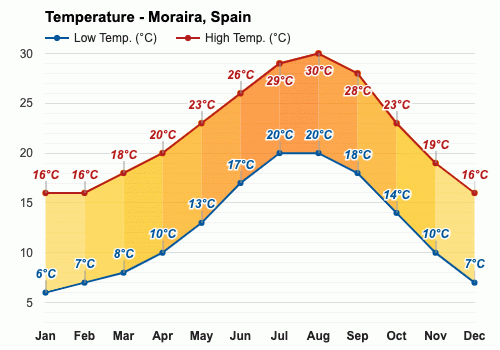Contents
- The climate of Moraira
- The best time to visit Moraira
- The worst time to visit Moraira
- Spring weather in Moraira
- Summer weather in Moraira
- Autumn weather in Moraira
- Winter weather in Moraira
- Weather in January
- Weather in February
- Weather in March
- Weather in April
- Weather in May
- Weather in June
- Weather in July
- Weather in August
- Weather in September
- Weather in October
- Weather in November
- Weather in December
- Frequently asked questions
- Average temperature
- Average rainfall
- Average rainfall days
- Average sea temperature
- Average daylight
- Average sunshine
- Average UV index

The climate of Moraira
The weather is characterized by hot summers and mild winters with substantial differences in temperatures and rainfall patterns throughout the year. The temperature sways between 6°C (42.8°F) in the cooler months to a peak of 30°C (86°F) during summer. There is also noticeable variation in rainfall, ranging from a minimal 9mm (0.35") in the driest month of July, to a substantial 81mm (3.19") in October.
As expected in Mediterranean climates, Moraira experiences the peak of daylight in June with nearly 14.8 hours of daylight. Notable weather patterns include high UV exposure during summer and an observable drop in the number of rainfall days from spring to summer.
The best time to visit Moraira
The worst time to visit Moraira
Spring weather in Moraira
Summer weather in Moraira
Autumn weather in Moraira
Winter weather in Moraira
Weather in January
Weather in February
Weather in March
Weather in April
Weather in May
Weather in June
Weather in July
Weather in August
Weather in September
Weather in October
Weather in November
Weather in December
Published by: Weather Atlas | About Us
Data Sources | Weather Forecasting & Climate
Frequently asked questions
What are the coldest months in Moraira?
How many days does it rain in Moraira?
When is the lowest UV index in Moraira?
What is the month with the coldest sea water in Moraira?
When are the longest days in Moraira?
When is the highest UV index in Moraira?
What is the driest month in Moraira?
What month has the most sunshine in Moraira?
What are the warmest months in Moraira?
When is the sea warmest in Moraira?
What is the rainiest month in Moraira?
When is Daylight Saving Time (DST) in Moraira?
What is the month with the shortest days in Moraira?
What is the month with the least sunshine in Moraira?
Average temperature
Moraira, Spain

The warmest month (with the highest average high temperature) is August (30°C).
The months with the lowest average high temperature are January, February and December (16°C).
The months with the highest average low temperature are July and August (20°C).
The coldest month (with the lowest average low temperature) is January (6°C).
Average rainfall
Moraira, Spain

The wettest month (with the highest rainfall) is October (81mm).
The driest month (with the least rainfall) is July (9mm).
Average rainfall days
Moraira, Spain

- Average rainfall days in January:
13 days - Average rainfall days in February:
11 days - Average rainfall days in March:
11 days - Average rainfall days in April:
10 days - Average rainfall days in May:
9 days - Average rainfall days in June:
6 days
- Average rainfall days in July:
3 days - Average rainfall days in August:
4 days - Average rainfall days in September:
6 days - Average rainfall days in October:
10 days - Average rainfall days in November:
10 days - Average rainfall days in December:
12 days
The month with the highest number of rainy days is January (13 days).
The month with the least rainy days is July (3 days).
Average sea temperature
Moraira, Spain

The best month for swimming (with the highest average sea temperature) is August (26.3°C).
The coldest month (with the lowest average sea temperature) is February (14°C).
Average daylight / Average sunshine
Moraira, Spain

- Average daylight in January:
9h and 5min - Average daylight in February:
10h and 5min - Average daylight in March:
12h and 0min - Average daylight in April:
13h and 1min - Average daylight in May:
14h and 2min - Average daylight in June:
14h and 5min
- Average daylight in July:
14h and 4min - Average daylight in August:
13h and 4min - Average daylight in September:
12h and 2min - Average daylight in October:
11h and 1min - Average daylight in November:
10h and 1min - Average daylight in December:
9h and 3min
The month with the longest days is June (Average daylight: 14h and 48min).
The month with the shortest days is December (Average daylight: 9h and 30min).
The month with the most sunshine is July (Average sunshine: 11h).
The month with the least sunshine is December (Average sunshine: 5h).
Average UV index
Moraira, Spain

The months with the highest UV index are June and July (UV index 9).
The months with the lowest UV index are January and December (UV index 2).
Moraira, Spain
Weather forecast for your location
2. Allow the app to use your location


